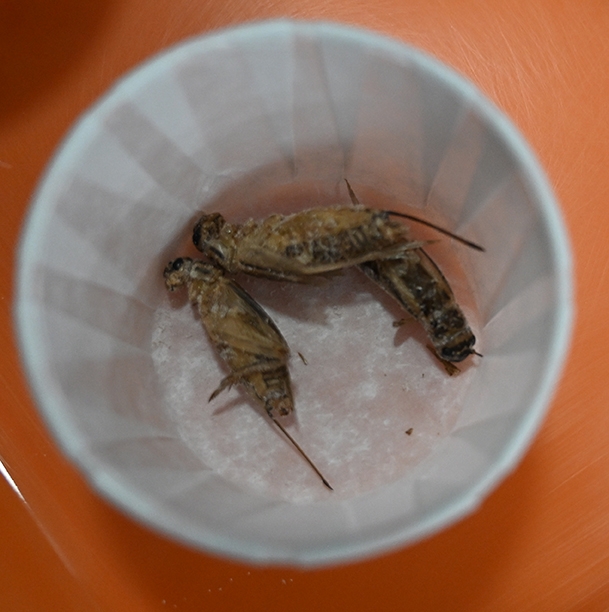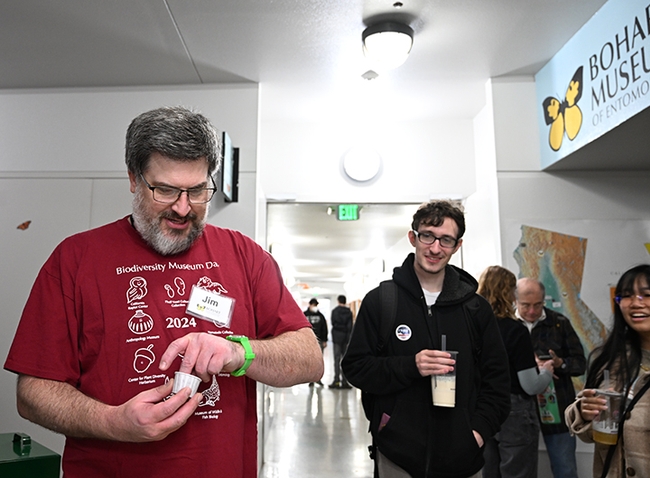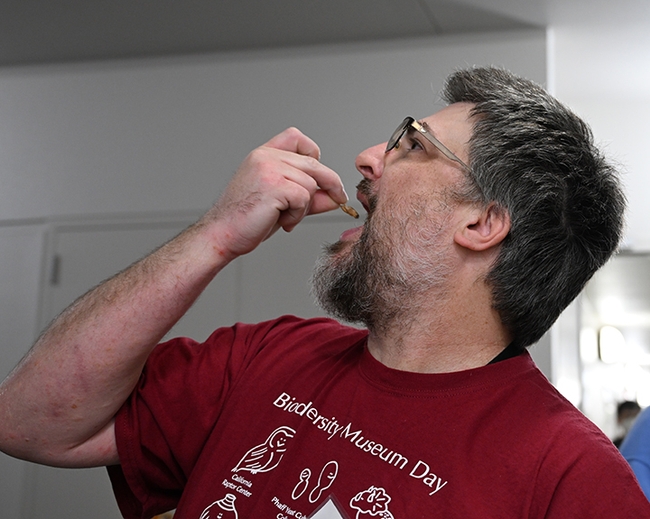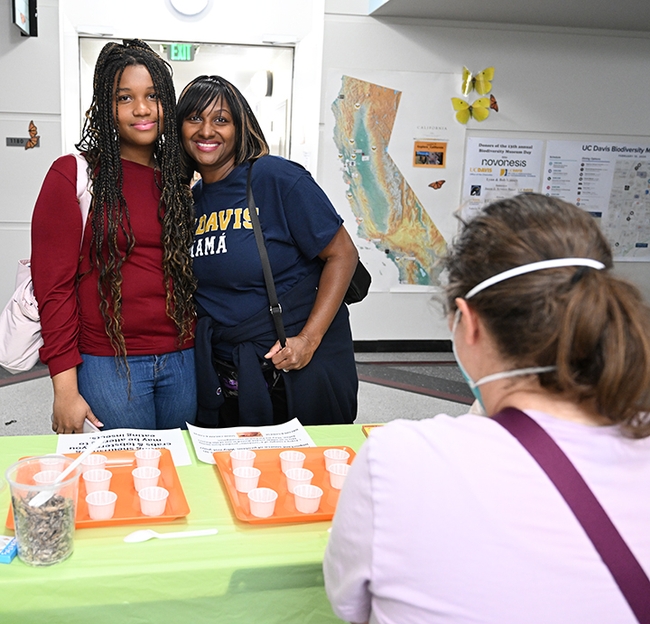
Tabatha Yang, education and outreach coordinator for the Bohart Museum of Entomology, sits at a table at a Bohart open house and points to a line of small paper cups, each containing three "Crickettes." The Crickettes, from the Hotlix company, are among the many items sold in the Bohart Museum's insect-themed gift shop.
"Eat a cricket!" a sign encourages. "People around the world eat insects as an important source of protein. Why not you?"
Some are bacon-flavored. Some are cheese-flavored.
The Bohart Museum's open house, themed "Specialized Predators of Insects," featured dragonflies and spiders. It took place Saturday, Nov. 2, during the UC Davis Parent and Family Weekend, an annual event providing parents and family members of current students "the opportunity to engage with UC Davis life — from academics to athletics and everything in between," according to UC Davis Alumni and Affiliate Relations.
And that included the opportunity to be "specialized predators" and sample crickets.
"Tastes like popcorn," a consumer said. "Bet you can't eat just one."
Said another: "They taste like empty sunflower seeds."
Postdoctoral research scientist James Starrett, of the arachnology lab of Professor Jason Bond, director of the Bohart Museum (and who serves as the Evert and Marion Schlinger Endowed Chair, UC Davis Department of Entomology and Nematology and associate dean, UC Davis College of Agricultural and Environmental Sciences), remembered eating them when he was in Vietnam in 2018 to present a workshop on "Arachnids and Myriapods" with Bond. "Lots of fun and very cool bugs there!"
"I have had crickets before, in Vietnam, but I think they were fried in oil then, so these were different," he said. "I agree with the description of texture 'like an empty sunflower seed,' but otherwise they tasted like the cheese and bacon salt. Not bad at all!"
"A lot of people enjoyed them," Yang related. "Families were challenging each other to try them. UC Davis students would try them if their parents would try them, so there were a lot of pictures taken of a parent and a student trying them at the same time."
"One UC Davis parent said that growing up in China the kids would just gather crickets during the summer and roast them over a fire to eat, so it was no big deal," Yang shared. "There was one kid who adored them. Each sample tasting cup had several crickettes. She enjoyed them so much, that I just filled a small cup for her and she was snacking on them."
Alumnae of the UC Davis Women's Ultimate Frisbee Team, the Rogues, stopped by. "There was a tournament on campus and when that was over, a few of them wanted to come over and check out the event," Yang said. "They all tried the crickettes together, so a team that plays together, eats crickets together."
Crickets are a good source of protein, fat, vitamins, minerals, and fiber and may help promote gut health, according to healthline.com. "Plus, they could be a more environmentally friendly protein source than other animal proteins such as chicken."
The word for eating insects, entomophagy, originates from the Greek words éntomon (insect) and phagein (to eat).
Entomology professor Erin Wilson-Rankin of UC Riverside, a former postdoctoral researcher (2010) in the Louie Yang lab. UC Davis Department of EntomologyandNematology, teaches a course for non-majors about the history of insects, including entomophagy. UC Riverside senior public information officer Jules Bernstein recently featured her in an article in the university's magazine.
Globally, more than 8 billion people regularly consume insects, and the practice is "good for our health and environment," Wilson-Rankin told Bernstein. "Raising insects for food does not impact the environment in the same way that chicken or beef does. It's more sustainable, so even people who prefer avoiding beef and chicken may be inspired to use this as a form of protein because of the environmental benefits. Way fewer greenhouse gases are involved compared to raising pigs or cattle. It is just a more sustainable way to feed people and could help contribute to global food security."
"You'll find the practice more common in countries closer to the equator," she shared. "Globally, beetles are the most common insects to be consumed, followed by butterflies and moths. People usually go for the larvae, because they're soft protein bags of goo, or the pupae, a form in between larva and the adult stage."
"There are geographic patterns that determine which insects are the most commonly eaten. Caterpillars are super popular in sub-Saharan Africa. You'll find ants, wasps, and bees are most common in Latin America, where they're very abundant. In Colombia, they roast ants and make flour from them. People collect ant larvae from agave fruits and put them in burritos or garlic sauce."
Available in Bohart Gift Shop. Those who missed the free samples at the Bohart Museum open house can purchase packages of the HotLix "Crickettes" in the Bohart Museum's insect-themed gift shop. (Contact: bmuseum@ucdavis.edu)
The Bohart Museum, located in Room 1124 of the Academic Surge Building, 455 Crocker Lane, UC Davis campus, is the home of a global collection of eight million insect specimens. It also includes a live petting zoo that includes Madagascar hissing cockroaches, stick insects and tarantulas.
Just don't eat the live petting zoo tenants. However, people in some parts of the world eat tarantulas and Madagascar hissing cockroaches, also known as "hissers." Street vendors in Cambodia serve fried tarantulas as a delicacy and a staple food; they are often eaten by the handfuls. Hissers are the main ingredient in Roach Stir Fry, Roach Fondue, Roach Tacos and Roach Burritos.
Fact is, just as some farmers specialize in cricket farming, some specialize in roach farming.
Bon appétit!
Attached Images:

Postdoctoral research scientist James Starrett, of the arachnology lab of Professor Jason Bond, director of the Bohart Museum, gets ready to eat a crickette. (Photo by Kathy Keatley Garvey)

Down the hatch! UC Davis research scientist and arachnoogist James Starrett enjoying a crickette. (Photo by Kathy Keatley Garvey)

UC Davis student Nia Rhodes, an atmospheric science major, stopped by the cricket booth with her mother, Elizabeth Rhodes of Los Angeles, who is wearing a "UC Davis Mama" shirt. It was Davis Parent and Family Weekend. In the foreground is Tabatha Yang, the Bohart Museum's education and outreach coordinator. (Photo by Kathy Keatley Garvey)